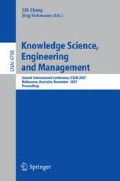Abstract
We presented a quotient space model that can represent a problem at different granularities; each model has three components: the universe X, property f and structure T. So a multi-granular analysis can be implemented based on the model. The basic properties among different quotient spaces such as the falsity preserving, the truth preserving properties are discussed. There are three quotient-space model construction approaches, i.e., the construction based on universe, based on property and based on structure. Four examples are given to show how a quotient space model can be constructed from a real problem and how benefit we can get from the multi-granular analysis. First, by adding statistical inference method to heuristic search, a statistical heuristic search approach is presented. Due to the hierarchical and multi-granular problem solving strategy, the computational complexity of the new search algorithm is reduced greatly. Second, in the collision-free paths planning in robotics, the topological model is constructed from geometrical one. By using the truth preserving property between these two models, the paths planning can be implemented in the coarser and simpler topological space so that the computational cost is saved. Third, we discuss the quotient space approximation and the multi-resolution signal analysis. And the second-generation wavelet analysis can be obtained from quotient-space based function approximation. It shows the equivalence relation between the quotient space model based analysis and wavelet transform. Fourth, in the automatic assembly sequence planning of mechanical product, we mainly show how a quotient structure can be constructed from the original one. By using the simpler quotient structure, the assembly sequence planning can be simplified greatly. In conclusion, the quotient-space model enables us to implement a multi-granular analysis. And we can get great benefit from the analysis.
Access this chapter
Tax calculation will be finalised at checkout
Purchases are for personal use only
Author information
Authors and Affiliations
Editor information
Rights and permissions
Copyright information
© 2007 Springer-Verlag Berlin Heidelberg
About this paper
Cite this paper
Zhang, L., Zhang, B. (2007). Quotient Space Based Multi-granular Analysis. In: Zhang, Z., Siekmann, J. (eds) Knowledge Science, Engineering and Management. KSEM 2007. Lecture Notes in Computer Science(), vol 4798. Springer, Berlin, Heidelberg. https://doi.org/10.1007/978-3-540-76719-0_5
Download citation
DOI: https://doi.org/10.1007/978-3-540-76719-0_5
Publisher Name: Springer, Berlin, Heidelberg
Print ISBN: 978-3-540-76718-3
Online ISBN: 978-3-540-76719-0
eBook Packages: Computer ScienceComputer Science (R0)

